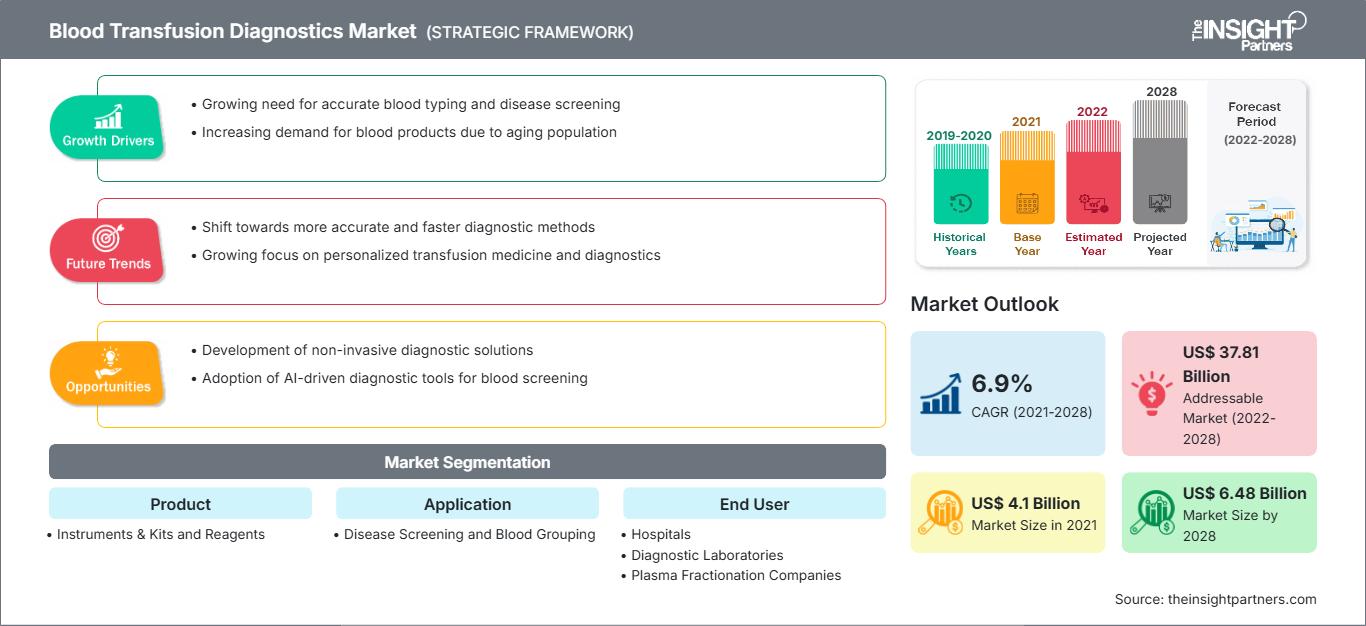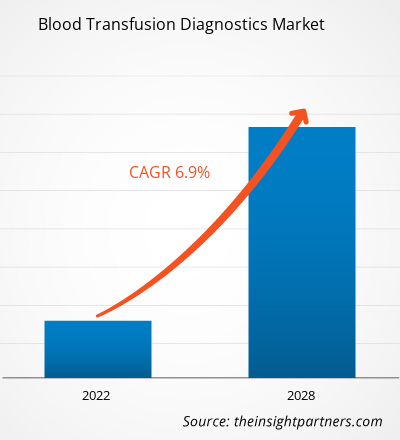[Forschungsbericht]Der Markt für Bluttransfusionsdiagnostik wird voraussichtlich von 4.096,93 Millionen US-Dollar im Jahr 2021 auf 6.483,75 Millionen US-Dollar im Jahr 2028 wachsen. Von 2022 bis 2028 wird mit einer durchschnittlichen jährlichen Wachstumsrate von 6,9 % gerechnet.
Bluttransfusionsdiagnostik umfasst Tests, die an Blut durchgeführt werden, bevor es Patienten transfundiert wird. Eine Bluttransfusion ist ein gängiges Verfahren, bei dem gespendetes Blut oder Blutbestandteile intravenös in den Körper des Patienten übertragen werden. Jede Bluteinheit muss einer Blutgruppenbestimmung unterzogen werden, bei der die Blutgruppe bestimmt und ein Blutscreening durchgeführt wird, einschließlich Tests zur Krankheitserkennung, um Nebenwirkungen oder die Übertragung von Infektionen zu vermeiden.
Der Bericht bietet Einblicke und eine eingehende Analyse des globalen Marktes für Bluttransfusionsdiagnostik und hebt verschiedene Parameter hervor, darunter Markttrends, technologische Fortschritte, Marktdynamik und eine Analyse der Wettbewerbslandschaft der weltweit führenden Marktteilnehmer. Er berücksichtigt auch die Auswirkungen der COVID-19-Pandemie auf den Markt in allen Regionen. Die COVID-19-Pandemie wirkte sich negativ auf das Wachstum des globalen Marktes für Bluttransfusionsdiagnostik aus. Sie führte zu einem enormen Umsatzrückgang aufgrund strenger staatlicher Beschränkungen, die zu einer geringeren Anzahl durchgeführter chirurgischer Eingriffe führten. Diese Leistungen werden hauptsächlich bei Operationen mit hohem Blutverlust, wie orthopädischen und Herzoperationen, in Anspruch genommen. Aufgrund der sinkenden Anzahl durchgeführter Operationen ist die Nachfrage nach Bluttransfusionen gesunken. Beispiel: Laut den von der American Medical Association veröffentlichten Daten wurde geschätzt, dass die Gesamtzahl der in den USA durchgeführten chirurgischen Eingriffe aufgrund der COVID-19-Pandemie um 48 % zurückgegangen ist. Nachdem sich die Pandemiebeschränkungen jedoch normalisiert hatten, normalisierte sich die Zahl der chirurgischen Eingriffe wieder.
Passen Sie diesen Bericht Ihren Anforderungen an
Sie erhalten kostenlos Anpassungen an jedem Bericht, einschließlich Teilen dieses Berichts oder einer Analyse auf Länderebene, eines Excel-Datenpakets sowie tolle Angebote und Rabatte für Start-ups und Universitäten.
Markt für Bluttransfusionsdiagnostik: Strategische Einblicke

- Holen Sie sich die wichtigsten Markttrends aus diesem Bericht.Dieses KOSTENLOSE Beispiel umfasst Datenanalysen, die von Markttrends bis hin zu Schätzungen und Prognosen reichen.
Sie erhalten kostenlos Anpassungen an jedem Bericht, einschließlich Teilen dieses Berichts oder einer Analyse auf Länderebene, eines Excel-Datenpakets sowie tolle Angebote und Rabatte für Start-ups und Universitäten.
Markt für Bluttransfusionsdiagnostik: Strategische Einblicke

- Holen Sie sich die wichtigsten Markttrends aus diesem Bericht.Dieses KOSTENLOSE Beispiel umfasst Datenanalysen, die von Markttrends bis hin zu Schätzungen und Prognosen reichen.
Geografische Einblicke
Geografisch ist der globale Markt für Bluttransfusionsdiagnostik in Nordamerika (USA, Kanada und Mexiko), Europa (Frankreich, Deutschland, Großbritannien, Spanien, Italien und das übrige Europa), den asiatisch-pazifischen Raum (China, Indien, Japan, Australien, Südkorea und der restliche Asien-Pazifik-Raum), den Nahen Osten und Afrika (Saudi-Arabien, die Vereinigten Arabischen Emirate, Südafrika und der restliche Nahe Osten und Afrika) sowie Süd- und Mittelamerika (Brasilien, Argentinien und der restliche Süd- und Mittelamerika) unterteilt.
Markteinblicke
Bedarf an Bluttransfusionen aufgrund der Zunahme von Organtransplantationen
Eine Organtransplantation ist ein chirurgischer Eingriff, der im Falle eines Organversagens durchgeführt wird. Organtransplantationen werden in der Regel an Herz, Leber, Niere und verschiedenen anderen Organen durchgeführt, da immer mehr chronische Krankheiten wie chronische Nierenerkrankung (CKD), polyzystische Nierenerkrankung, Mukoviszidose und angeborene Herzfehler eine Transplantation erfordern. Diese Eingriffe dauern in der Regel mehrere Stunden, sind mit hohem Blutverlust verbunden und erfordern Bluttransfusionen. Laut dem United Network for Organ Sharing (UNOS) beispielsweise hat die Zahl der in den USA durchgeführten Organtransplantationen kontinuierlich zugenommen; im Jahr 2021 wurden dort über 41.000 Transplantationen durchgeführt. Daten des Welttransplantationsregisters zufolge entfielen 2019 20 % aller Organspenden in Europa und 6 % weltweit auf Spanien. Australiens Organspenderquote hat sich in letzter Zeit verbessert und stieg 2019 auf 21,8 Spender pro Million Einwohner.
Ähnlich hat Kanada 22,2 Spender pro Million Einwohner und verbessert sich stetig, was teilweise auf die Zahl der „Spendeärzte“ zurückzuführen ist – Intensivmediziner, die für Organspenden zuständig sind. Laut dem Welttransplantationsregister gab es in China im Jahr 2019 5.818 Spender oder 4,1 pro Million Einwohner und in Indien 715 Spender oder 0,5 pro Million Einwohner im Jahr 2019. Russland hatte dagegen eine etwas höhere Quote von 5,1 Spendern pro Million Menschen. Die öffentlich-private Partnerschaft in Zusammenarbeit mit Transplantationskoordinatoren hat erheblich zur Verbesserung von Organtransplantationen beigetragen, die ständige Bluttransfusionen erfordern. Sowohl Entwicklungs- als auch Industrieländer erleben einen Anstieg der Organtransplantationen. Entwicklungsländer wie Indien und Singapur entwickeln sich beispielsweise zu Zielen für Medizintourismus in der Asien-Pazifik-Region. Die Länder machen Fortschritte bei der Bereitstellung besserer und fortschrittlicherer medizinischer Behandlungen. Der steigende Bedarf an Organtransplantationen ist einer der Hauptfaktoren, die die weltweite Nachfrage nach Bluttransfusionsdiagnostik antreiben.
Produktbasierte Erkenntnisse
Basierend auf dem Produkt ist der globale Markt für Bluttransfusionsdiagnostik in Instrumente & Kits und Reagenzien unterteilt. Im Jahr 2021 hatte das Segment Instrumente & Kits einen größeren Marktanteil. Für dasselbe Segment wird von 2022 bis 2028 eine höhere durchschnittliche jährliche Wachstumsrate (CAGR) erwartet.
Anwendungsbasierte Erkenntnisse
Basierend auf der Anwendung ist der globale Markt für Bluttransfusionsdiagnostik in Krankheitsscreening und Blutgruppenbestimmung unterteilt. Das Segment Krankheitsscreening hatte 2021 einen größeren Marktanteil und wird im Prognosezeitraum voraussichtlich eine höhere durchschnittliche jährliche Wachstumsrate (CAGR) verzeichnen.
BluttransfusionsdiagnostikRegionale Einblicke in den Markt für Bluttransfusionsdiagnostik
Regionale Einblicke in den Markt für Bluttransfusionsdiagnostik
Die Analysten von The Insight Partners haben die regionalen Trends und Faktoren, die den Markt für Bluttransfusionsdiagnostik im Prognosezeitraum beeinflussen, ausführlich erläutert. In diesem Abschnitt werden auch die Marktsegmente und die geografische Lage der Bluttransfusionsdiagnostik in Nordamerika, Europa, dem asiatisch-pazifischen Raum, dem Nahen Osten und Afrika sowie Süd- und Mittelamerika erörtert.
Umfang des Marktberichts zur Bluttransfusionsdiagnostik
| Berichtsattribut | Einzelheiten |
|---|---|
| Marktgröße in 2021 | US$ 4.1 Billion |
| Marktgröße nach 2028 | US$ 6.48 Billion |
| Globale CAGR (2021 - 2028) | 6.9% |
| Historische Daten | 2019-2020 |
| Prognosezeitraum | 2022-2028 |
| Abgedeckte Segmente |
By Produkt
|
| Abgedeckte Regionen und Länder | Nordamerika
|
| Marktführer und wichtige Unternehmensprofile |
|
Dichte der Marktteilnehmer im Bereich Bluttransfusionsdiagnostik: Auswirkungen auf die Geschäftsdynamik verstehen
Der Markt für Bluttransfusionsdiagnostik wächst rasant. Die steigende Nachfrage der Endverbraucher ist auf Faktoren wie veränderte Verbraucherpräferenzen, technologische Fortschritte und ein stärkeres Bewusstsein für die Produktvorteile zurückzuführen. Mit der steigenden Nachfrage erweitern Unternehmen ihr Angebot, entwickeln Innovationen, um den Bedürfnissen der Verbraucher gerecht zu werden, und nutzen neue Trends, was das Marktwachstum weiter ankurbelt.

- Holen Sie sich die Markt für Bluttransfusionsdiagnostik Übersicht der wichtigsten Akteure
Endnutzerbasierte Erkenntnisse
Basierend auf dem Endnutzer ist der globale Markt für Bluttransfusionsdiagnostik in Blutbanken, Krankenhäuser, Diagnoselabore und Plasmafraktionierungsunternehmen segmentiert. Das Segment Blutbanken hatte 2021 den größten Marktanteil. Es wird erwartet, dass dasselbe Segment von 2022 bis 2028 die höchste durchschnittliche jährliche Wachstumsrate (CAGR) auf dem Markt verzeichnet.
Die globalen Akteure auf dem Markt für Bluttransfusionsdiagnostik verfolgen organische Strategien, einschließlich Produkteinführung und -erweiterung, um ihre Präsenz und ihr Produktportfolio weltweit zu erweitern und die wachsende Nachfrage zu decken. Die wichtigsten Akteure auf dem Markt sind Grifols, SA; F. Hoffmann-La Roche Ltd; Immucor, Inc.; Bio-Rad Laboratories, Inc.; Abbott; Thermo Fisher Scientific Inc.; Ortho Clinical Diagnostics; DiaSorin SpA; Quotient Limited; und BAG Diagnostics GmbH.
- Historische Analyse (2 Jahre), Basisjahr, Prognose (7 Jahre) mit CAGR
- PEST- und SWOT-Analyse
- Marktgröße Wert/Volumen – Global, Regional, Land
- Branchen- und Wettbewerbslandschaft
- Excel-Datensatz
Aktuelle Berichte
Verwandte Berichte
Erfahrungsberichte
Grund zum Kauf
- Fundierte Entscheidungsfindung
- Marktdynamik verstehen
- Wettbewerbsanalyse
- Kundeneinblicke
- Marktprognosen
- Risikominimierung
- Strategische Planung
- Investitionsbegründung
- Identifizierung neuer Märkte
- Verbesserung von Marketingstrategien
- Steigerung der Betriebseffizienz
- Anpassung an regulatorische Trends






















 Kostenlose Probe anfordern für - Markt für Bluttransfusionsdiagnostik
Kostenlose Probe anfordern für - Markt für Bluttransfusionsdiagnostik